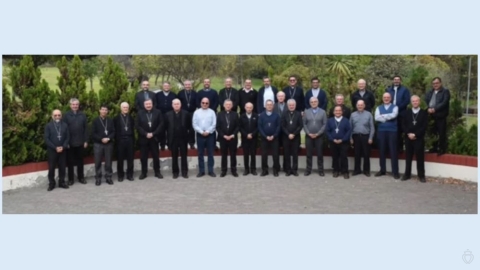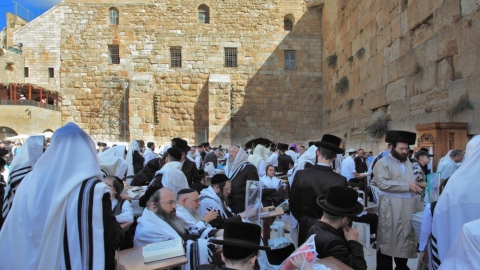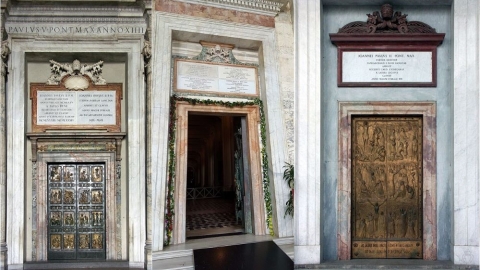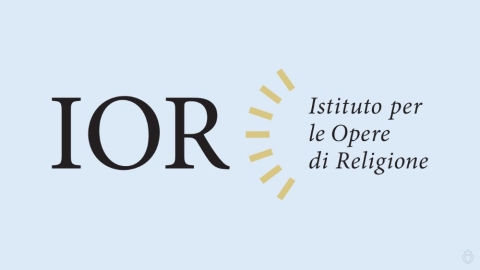The Holy Land: a sign for our time

Because it displayed its vice, the city of Sodom was chastised by God and became the symbol of iniquity, just like Gomorrah, its neighbor in the Canaanite Decapolis.[1] The Book of Genesis relates how “the Lord rained upon Sodom and Gomorrah brimstone and fire from the Lord out of heaven. And he destroyed these cities, and all the country about: all the inhabitants of the cities, and all things that spring from the earth” (Gen 19:24-25). Then Abraham saw from afar “the ashes rise up from the earth as the smoke of a furnace” (19:28). “It was a rain of fire that set fire to the bitumen in the subsoil, between Jericho and the Dead Sea, so that the cities collapsed in the midst of the flames and the ground sank and was overrun by the waters of the Dead Sea,” explains Father Tintori, O.F.M.[2] The devastated region was abandoned but remained in human memory.
Since then the locality of Sodom has been uncertain. Traditionally, as we can read in Flavius Josephus, Strabon or Saint Jerome, it is situated in the southern part of the Dead Sea, at its southwestern extremity, where the mountain of rock salt Jebel Usdum stands.[3] In this region, around 1900 B.C., the cataclysm occurred that destroyed Sodom and Gomorrah, cities in the Siddim Valley, “which is now the salt sea”, the Bible explains (Gen 14:3).
Another theory, devised in the years after archaeological excavations were conducted in 1929 by the Pontifical Biblical Institute, puts the remains of the accursed city to the northeast of the Dead Sea, near the mouth of the Jordan. The remains of a very ancient city, going back to the Chalcolithic Era and destroyed during the first period of the Bronze Age (around 1800 B.C.), were unearthed amid a great mass of ashes present everywhere on the site.[4] Situated in Teleilât-Ghassûl, the ruins testify to the existence of an important city on the plain of the Jordan River, although it is not possible to say with certainty that this is in fact the ancient city destroyed by God’s wrath.
Another site, situated to the east of the El Lisan peninsula, at Bab edh-Dhra, in the Wadi Kerak, was excavated beginning in 1973 by American archaeologists Walter Rast and Thomas Schaub. They were able to list a total of five cities dating back to the archaic Bronze Age (approx. 3200-2300 B.C.), two of which—Bab edh-Dhra and Numeira—show traces of violent destruction with earthquakes and general conflagration, which did not spare even the vast cemeteries situated in the vicinity.
Today a team of American archaeologists is asserting, at the conclusion of their sixth season of excavations, that the Tall-el-Hammam site could conceal the place where once stood “a mighty city during the early and middle Bronze Age (between 3500 and 1540 B.C.)”. The remains of a gold mine, traces of “a massive defending wall, a palace and a set of gates” have been discovered.[5] According to the explanation by Professor Steven Collins, director of the research, several indications suggest that “this flourishing city was suddenly abandoned toward the end of the Bronze Age,” possibly because of “destruction by fire”.[6] This, he proposes, would be ancient Sodom. The ruins are situated 13 kilometers [8 miles] north of the Dead Sea, about twenty kilometers [12 miles] east of the left bank of the Jordan. Tall-el-Hammam continues to be the object of an ambitious project of digs and excavation.
Although great prudence is still called for, the announcement of the discovery of ancient Sodom right in the middle of the Synod on the Family that is taking place at this very moment in Rome is perhaps not an entirely fortuitous coincidence. At the beginning of Vatican Council II, Pope John XXIII intended to scrutinize the signs of the times so as to urge the Church to listen to the world, to its expectations and aspirations.[7] Fifty years later, here is a “sign of the times” that tolls like a terrible warning.
(Sources: dubuit/keller/lemaire/renié/apic/bible.archeologie – DICI no. 323 dated October 23, 2015)
[1] Michel Du Buit, “Sodome”, in: Dictionnaire encyclopédique de la Bible (Brépols, 1987), 539 and 1215.
[2] In note 25 on that passage in La Sainte Bible selon la Vulgate, translated by Fr. Glaire (D.F.T., 1992), 27.
[3] Ibid. See also Fr. Lagrange, O.P., “Le site de Sodome d’après les textes”, Revue Biblique (1932): 489-514. According to Werner Keller, “Jebel Usdum is a very old name in which the radical of the word Sodom is preserved” (La Bible arrachée aux sables, [Chambéry: Amiot-Dumont, 1956], 74).
[4] J. Renié, Manuel d’Écriture Sainte, vol. I (Lyons: Emmanuel Vitte, 1949), no. 316, p. 501. P. Lemaire, O.F.M., “L’archéologie biblique”, in: Robert and Tricot, eds., Initiation biblique (Desclée, 1939), 409.
[5] APIC, October 14, 2015, citing The Huffington Post, October 13, 2015.
[6] Ibid.
[7] See John XXIII, Apostolic Constitution convoking the Council, Humanae salutis (25 December 1961); Encyclical Letter Pacem in terris (11 April 1963). See also Vatican Council II, Pastoral Constitution Gaudium et spes (7 December 1965), chap. 4.
Read also :
The Synod and “shameful affections”





